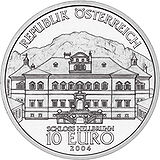
Schloss Hellbrunn
Encyclopedia

Baroque
The Baroque is a period and the style that used exaggerated motion and clear, easily interpreted detail to produce drama, tension, exuberance, and grandeur in sculpture, painting, literature, dance, and music...
villa
Villa
A villa was originally an ancient Roman upper-class country house. Since its origins in the Roman villa, the idea and function of a villa have evolved considerably. After the fall of the Roman Republic, villas became small farming compounds, which were increasingly fortified in Late Antiquity,...
of palatial size, near Morzg, a southern district of the city of Salzburg
Salzburg
-Population development:In 1935, the population significantly increased when Salzburg absorbed adjacent municipalities. After World War II, numerous refugees found a new home in the city. New residential space was created for American soldiers of the postwar Occupation, and could be used for...
, Austria
Austria
Austria , officially the Republic of Austria , is a landlocked country of roughly 8.4 million people in Central Europe. It is bordered by the Czech Republic and Germany to the north, Slovakia and Hungary to the east, Slovenia and Italy to the south, and Switzerland and Liechtenstein to the...
. It was built in 1613-19 by Markus Sittikus von Hohenems, Prince-Archbishop of Salzburg
Archbishopric of Salzburg
The Archbishopric of Salzburg was an ecclesiastical State of the Holy Roman Empire, its territory roughly congruent with the present-day Austrian state of Salzburg....
, and named for the "clear spring" that supplied it. Hellbrunn was only meant for use as a day residence in summer, as the Archbishop usually returned to Salzburg in the evening. Therefore, there is no bedroom in Hellbrunn.
Overview

Jeux d'eau
Jeux d'eau or "water games", is an umbrella term in the history of gardens for the "water features" that were introduced into mid-16th century Mannerist Italian gardens...
("watergames") in the grounds, which are a popular tourist attraction in the summer months. These games were conceived by Markus Sittikus, a man with a keen sense of humour, as a series of practical jokes to be performed on guests. Notable features include stone seats around a stone dining table through which a water conduit sprays water into the seat of the guests when the mechanism is activated, and hidden fountains that surprise and spray guests while they take part on the tour. Other features are a mechanical, water-operated and music-playing theatre
Water organ
The water organ or hydraulic organ is a type of pipe organ blown by air, where the power source pushing the air is derived by water from a natural source or by a manual pump...
built in 1750 showing various professions at work, a grotto and a crown being pushed up and down by a jet of water, symbolising the rise and fall of power. At all of these games there is always a spot which is never wet: that where the Archbishop stood or sat, to which there is no water conduit and which is today occupied by the tour guide.

The Castle of Hellbrunn Coin

See also
- King Alfonso II of Naples and the Poggio Reale – surprise jets of water in the garden

